Yosemite National Park is one of America’s most iconic natural treasures, drawing millions of visitors each year to its towering granite cliffs, ancient sequoia groves, and thunderous waterfalls. But beyond the jaw-dropping views from the roadside lies something even more rewarding – experiencing Yosemite on foot. Yosemite National Park hiking offers some of the most unforgettable journeys through nature in the entire country, where each trail leads to a new perspective, a hidden gem, or a moment of quiet solitude surrounded by wilderness.
In this guide, the National Park Shops team have carefully selected and reviewed 15 of the best Yosemite National Park hiking trails, each with detailed insights into the experience it offers. You’ll find essential information like total distance, estimated hiking time, elevation gain, and the difficulty level so you can choose the right trail for your skills and schedule. Whether you’re planning a full-day adventure or just want to stretch your legs for an hour, these hikes will help you experience the heart of Yosemite in a way that no scenic overlook ever could.
Bridalveil Fall Trail
- Difficulty: Easy
- Distance: 0.5 miles (0.8 km) round trip
- Elevation Gain: Approximately 80 ft (24 m)
- Time: 20 minutes
Among the most iconic short hikes in the Yosemite Valley floor, the Bridalveil Fall Trail is an excellent introduction to the beauty and accessibility of Yosemite National Park hiking. This brief yet scenic walk begins just off the main road and quickly immerses hikers in towering granite cliffs and the echo of rushing water. The path is paved and relatively flat, making it suitable for all ages and fitness levels, including families with children or visitors with limited time. As you approach the base of Bridalveil Fall, the trail opens up to a viewing area where the 620-foot waterfall dramatically crashes down from the cliffs above.
Spring is the most breathtaking season for this trail, when melting snow fuels the waterfall’s peak flow, and the surrounding rocks are shrouded in mist. The spray often creates shimmering rainbows on sunny days, offering exceptional photography opportunities. Although the trail is short, the sensory experience, the sound of water, the cool mist, and the fresh forest air, is deeply rewarding. For those starting their Yosemite National Park hiking adventure or simply seeking a memorable yet low-effort excursion, Bridalveil Fall Trail delivers a perfect blend of drama and accessibility in under 30 minutes.

READ MORE:
- Yosemite National Park Weather: Monthly Suggestions
- 11 Best Hotels Near Yosemite National Park: Reservations Request
Lower Yosemite Fall Trail
- Difficulty: Easy
- Distance: 1 mile (1.6 km) loop
- Elevation Gain: Approximately 50 ft (15 m)
- Time: 30 minutes

The Lower Yosemite Fall Trail is one of the most accessible and frequently visited routes in the Yosemite Valley. This loop trail provides a close-up encounter with the lower section of Yosemite Falls, part of the tallest waterfall in North America. It’s a great introduction to Yosemite National Park hiking, especially for first-time visitors or those looking for a flat, stroller-friendly path. Along the way, interpretive signs offer historical and ecological insights, making it an educational as well as scenic experience.
In the spring and early summer, the falls thunder with snowmelt, creating mist that cools and refreshes hikers as they approach the base. The short distance and smooth pavement make it a top choice for families, photographers, and anyone looking to soak in Yosemite’s natural splendor without committing to a strenuous route. Benches are available for those who want to sit and simply admire the falls. As part of the wider Yosemite National Park hiking network, this trail offers maximum reward with minimal effort.
Mist Trail
- Difficulty: Strenuous
- Distance: 3 miles (4.8 km) round trip to Vernal Fall; 7 miles (11 km) round trip to Nevada Fall
- Elevation Gain: 1,000 ft (300 m) to Vernal Fall; 1,900 ft (580 m) to Nevada Fall
- Time: 2–5 hours
Arguably one of the most iconic Yosemite National Park hiking experiences, the Mist Trail takes you right into the heart of two of the park’s most powerful waterfalls. The trail begins on a paved incline before giving way to a steep granite staircase carved into the cliffs beside Vernal Fall. During peak runoff in late spring, hikers are often drenched by the mist, hence the name, making it a thrilling and immersive experience. Well-placed railings add safety, but hikers should wear proper footwear as the rocks can be slick.
Continuing past Vernal Fall leads to the equally breathtaking Nevada Fall. The trail becomes quieter beyond Vernal, with fewer crowds and even more dramatic views. This route is physically demanding but consistently rewarding, filled with roaring water, rainbows, and scenic overlooks. It’s a highlight of any Yosemite National Park hiking itinerary for those with the stamina to complete it.
>> Read More: Experience Sunrise Yosemite: 5 Best Places To Watch

Rancheria Falls
- Difficulty: Moderate
- Distance: 13 miles (21 km) round trip
- Elevation Gain: 800 ft (240 m)
- Time: 5–8 hours
Rancheria Falls offers one of the best long-distance Yosemite National Park hiking experiences in the Hetch Hetchy region. Starting at O’Shaughnessy Dam, this scenic trail follows the shoreline of Hetch Hetchy Reservoir and then winds through wildflower-filled meadows and forests. It’s a quieter, less-traveled route that reveals a more remote and peaceful side of the park. The highlight is Rancheria Falls, a broad, cascading waterfall spread across multiple levels of granite ledge.
Though the trail is long, the gradual incline makes it suitable for hikers with moderate experience. Along the way, you’ll find many opportunities for birdwatching, photography, and solitude. It’s also a popular backpacking route, with backcountry permits available for overnight stays. For those who want to explore beyond Yosemite Valley, Rancheria Falls delivers a rewarding escape into nature.
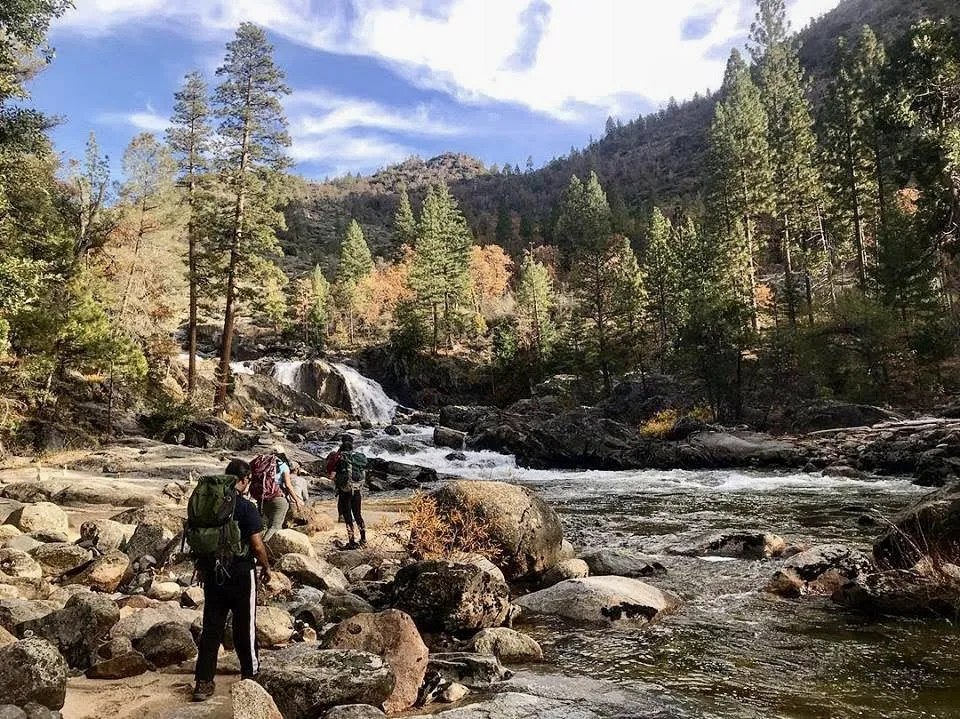
Upper Yosemite Falls Trail
- Difficulty: Strenuous
- Distance: 7.6 miles (12 km) round trip
- Elevation Gain: 2,700 ft (823 m)
- Time: 6–8 hours
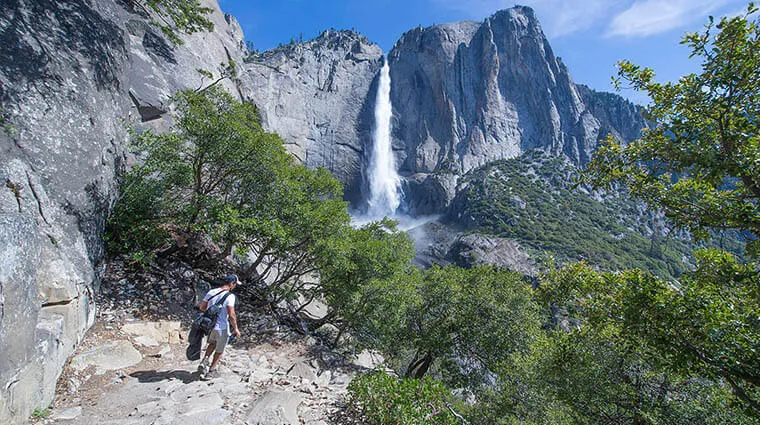
The Upper Yosemite Falls Trail is a legendary route in the Yosemite National Park hiking network, known for its steep switchbacks and extraordinary payoff at the summit. Starting near Camp 4, the trail wastes no time climbing, delivering a leg-burning ascent that tests both your physical and mental stamina. Hikers gain more than 2,700 feet in just under four miles, passing through shaded oak forests before reaching exposed granite ledges with sweeping views. One of the most memorable waypoints is Columbia Rock, a perfect place to pause and catch your breath while soaking in panoramic views of Yosemite Valley.
Continuing the climb brings hikers face to face with Upper Yosemite Fall itself, roaring with power in the spring and providing a peaceful trickle in late summer. At the top, a railed viewing area allows you to look straight over the cliff’s edge, offering heart-pounding views of the valley below and the Merced River winding through it. This hike is not for the faint of heart, but those who complete it are rewarded with one of the most iconic and awe-inspiring sights in the Sierra Nevada. Among the most challenging Yosemite National Park hiking trails, this route is a must-do for serious trekkers seeking high-altitude rewards.
RELATED POST:
- Road Trip San Francisco To Yosemite National Park: Things To Note
- Guide to Yosemite National Park Winter: Top Activities
Half Dome Day Hike
- Difficulty: Very Strenuous
- Distance: 14–16 miles (22–26 km) round trip
- Elevation Gain: 4,800 ft (1,463 m)
- Time: 10–14 hours
The Half Dome Day Hike is perhaps the most iconic and demanding Yosemite National Park hiking experience. It combines steep elevation gain, exposed granite switchbacks, and the famous cable ascent that leads to the summit of one of Yosemite’s most recognizable landmarks. This adventure begins on the Mist Trail or John Muir Trail and gradually becomes more rigorous, culminating in a climb up the back of Half Dome using metal cables bolted into the rock. Permits are required and awarded via lottery, and hikers should be well-conditioned, prepared for altitude, and comfortable with heights.
Reaching the summit reveals a 360-degree view that stretches across the entire Yosemite Valley and beyond. From towering peaks to serene alpine meadows, the landscape is unforgettable. Because of its difficulty, this hike is recommended only for experienced hikers with proper gear and conditioning. But for those who complete it, the Half Dome Hike is a bucket-list Yosemite National Park hiking triumph like no other.
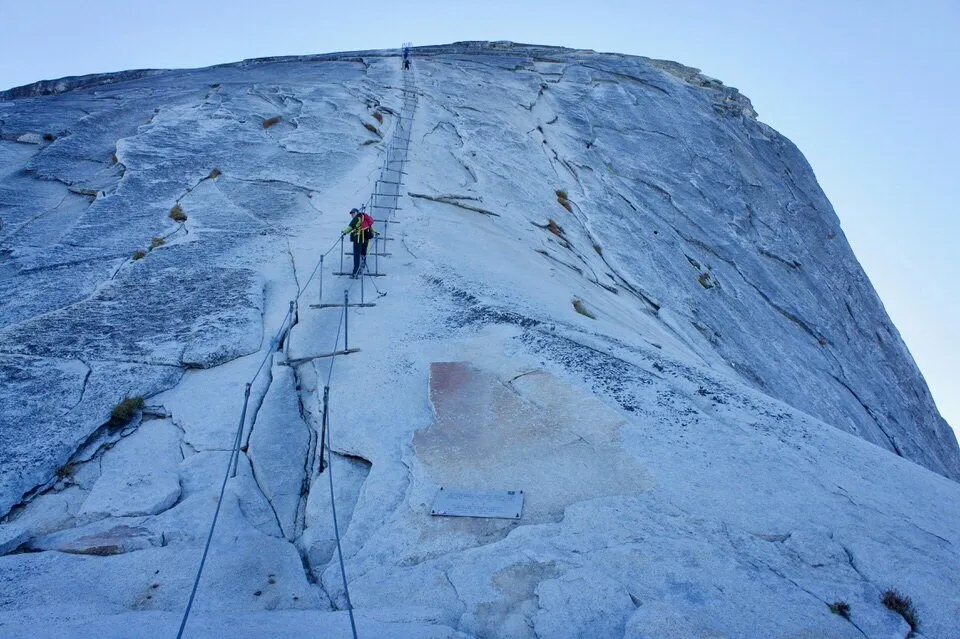
Vernal Fall (Short Version of Mist Trail)
- Difficulty: Moderate
- Distance: 1.6 miles (2.6 km) round trip to Vernal Fall Footbridge
- Elevation Gain: 400 ft (120 m)
- Time: 1–1.5 hours
This shorter version of the Mist Trail leads to the Vernal Fall Footbridge, providing a fantastic option for those who want a taste of Yosemite National Park hiking without taking on the full Mist Trail. The paved section up to the footbridge offers solid footing, but it’s still a workout due to the steady incline. The view from the bridge is exceptional, hikers can see Vernal Fall gushing down granite cliffs while enjoying the cooling mist. It’s a perfect introduction to the park’s dynamic water features.
Because it’s a short trail, it’s popular with families and casual hikers. Spring is the best time to visit when water flow is at its peak and wildflowers line the trail. While many continue to Nevada Fall, this short hike offers impressive scenery without the physical demand. It’s one of the best Yosemite National Park hiking options for visitors short on time but not willing to compromise on views.
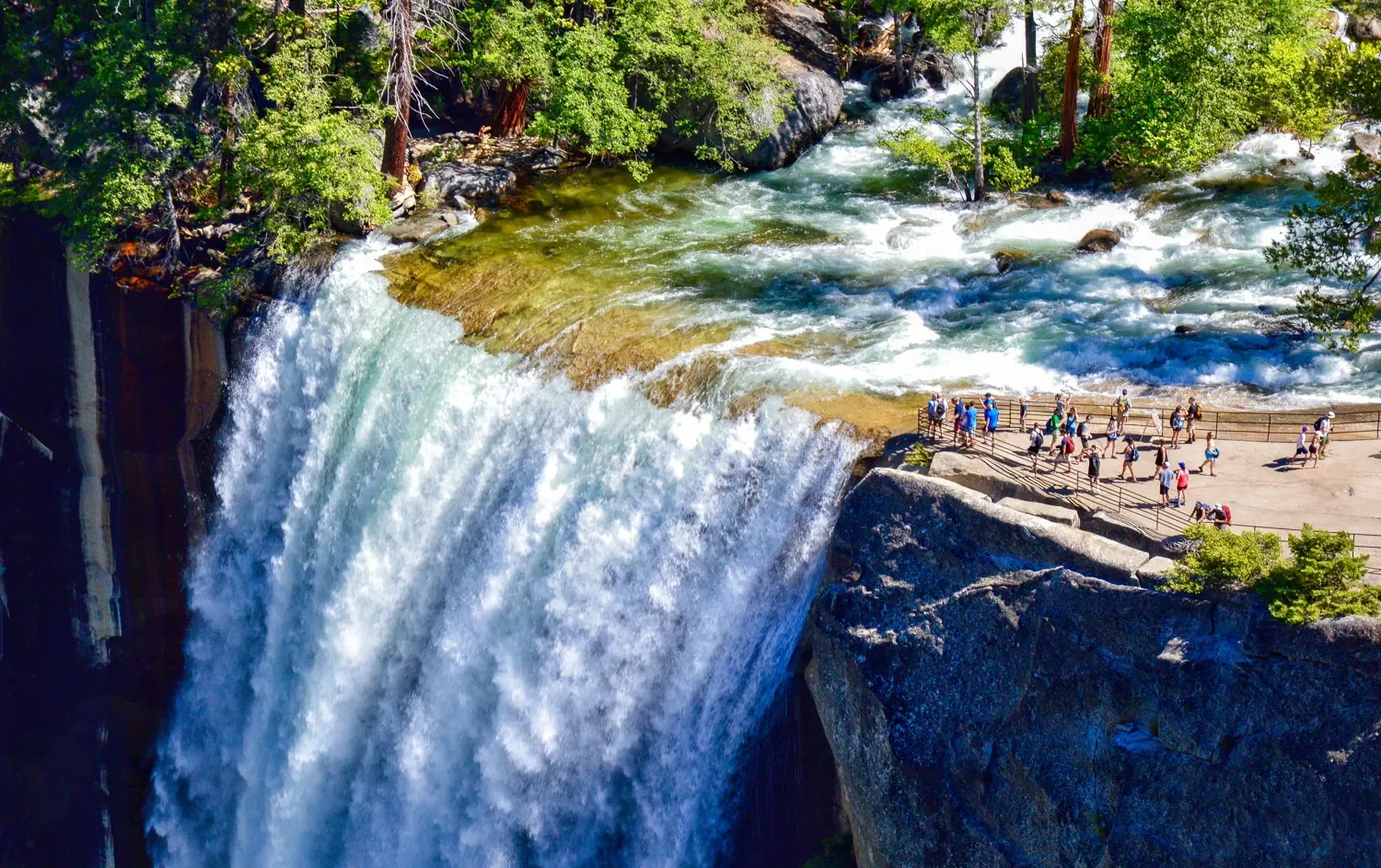
Mirror Lake Loop
- Difficulty: Easy to Moderate
- Distance: 2 miles (3.2 km) round trip to the lake; 5 miles (8 km) for the full loop
- Elevation Gain: 100 ft (30 m)
- Time: 1–2 hours
Mirror Lake is a popular destination for hikers seeking serenity and reflection, both literally and figuratively. The trail leads to a seasonal lake located at the base of Half Dome, offering captivating views of the massive granite walls reflected in the still waters. Though often dry in late summer, the area’s beauty endures, especially in spring when water levels are high. The trail is flat and family-friendly, with an optional full loop around Tenaya Creek for those looking for a longer walk.
Wildlife sightings are common here, including deer and songbirds, and the shaded sections offer relief during warmer months. As an introduction to Yosemite National Park hiking, Mirror Lake delivers maximum peace with minimal effort. The wide trail also makes it a great choice for casual walkers, photographers, and those wanting a tranquil start to their Yosemite adventure. Despite its easy nature, the scenery is classic Yosemite, towering rock walls, fresh pine air, and natural quietude.
>> Read More: Yosemite Sunset: The 7 Best Spots To Watch The Sunset

Columbia Rock Trail
- Difficulty: Moderate
- Distance: 2 miles (3.2 km) round trip
- Elevation Gain: 1,000 ft (328 m)
- Time: 2–3 hours
This trail leads to Columbia Rock, a granite perch that rewards hikers with breathtaking panoramic views of Yosemite Valley, including iconic sights like Half Dome, Sentinel Rock, and the meandering Merced River below. The trail climbs steadily via a series of well-defined switchbacks, gaining around 1,000 feet in elevation over just one mile, which makes it an excellent option for hikers who want a moderate challenge without committing to a full-day ascent. Along the route, you’ll pass through shaded stretches of pine and oak forest, offering moments of relief before opening up to sun-exposed granite outcrops that gradually reveal more of the valley floor with each step.
Though it’s a shorter alternative to the more demanding Upper Yosemite Falls Trail, Columbia Rock delivers an impressive payoff in a relatively short amount of time. It’s a fantastic choice for those new to Yosemite National Park hiking, or for anyone looking to squeeze in a rewarding hike with time to spare for other park highlights. Early morning starts are ideal, with cooler air, soft light illuminating the cliffs, and fewer hikers on the trail. Whether you’re photographing the valley from above or simply savoring the stillness of the high country, Columbia Rock offers a compact but powerful Yosemite hiking experience.
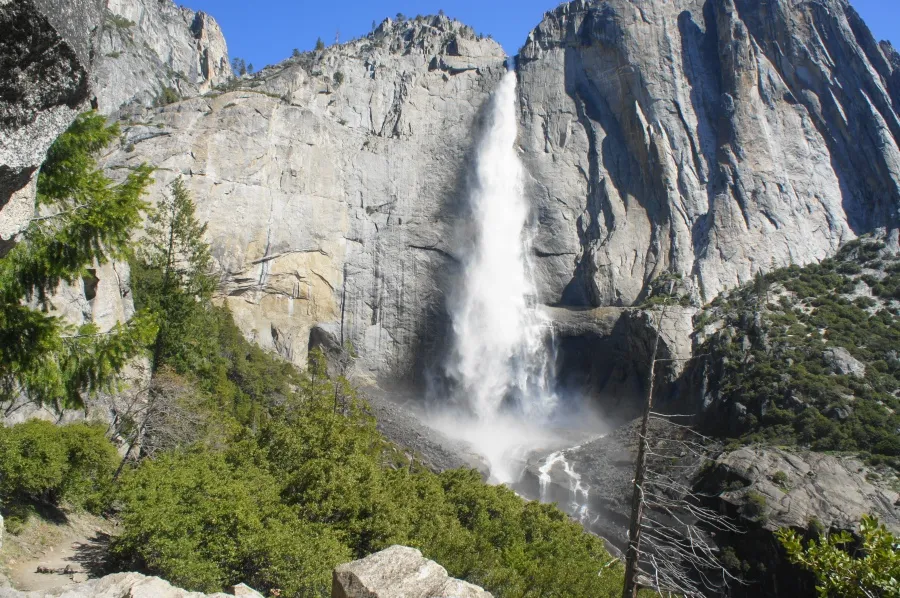
Sentinel Meadow & Cook’s Meadow Loop Trail
- Difficulty: Easy
- Distance: 1 mile (1.6 km) loop
- Elevation Gain: Flat
- Time: 30–45 minutes
The Sentinel Meadow & Cook’s Meadow Loop Trail is a gentle, scenic walk through two of Yosemite Valley’s most beautiful open spaces. It offers unmatched, unobstructed views of Yosemite Falls, Half Dome, and Sentinel Rock, making it a favorite for early risers and sunset chasers. As one of the most accessible Yosemite National Park hiking trails, it features boardwalks and dirt paths suitable for nearly all ages and mobility levels. The wide-open meadows bloom with wildflowers in the spring and summer, and the shifting light throughout the day gives photographers endless opportunities to capture stunning compositions.
Interpretive signs placed throughout the loop share stories about the park’s ecology, history, and cultural significance. This loop is ideal for a warm-up walk before more ambitious hikes or as a quiet retreat after a full day of exploring. The trail is also a great choice for birdwatchers and wildlife observers hoping to spot deer grazing in the early morning light. Among Yosemite National Park hiking routes, this loop stands out for its tranquility and accessibility without sacrificing breathtaking views.
>> Read More: The 15 Best Yosemite Restaurants: Inside and Outdoor Dining
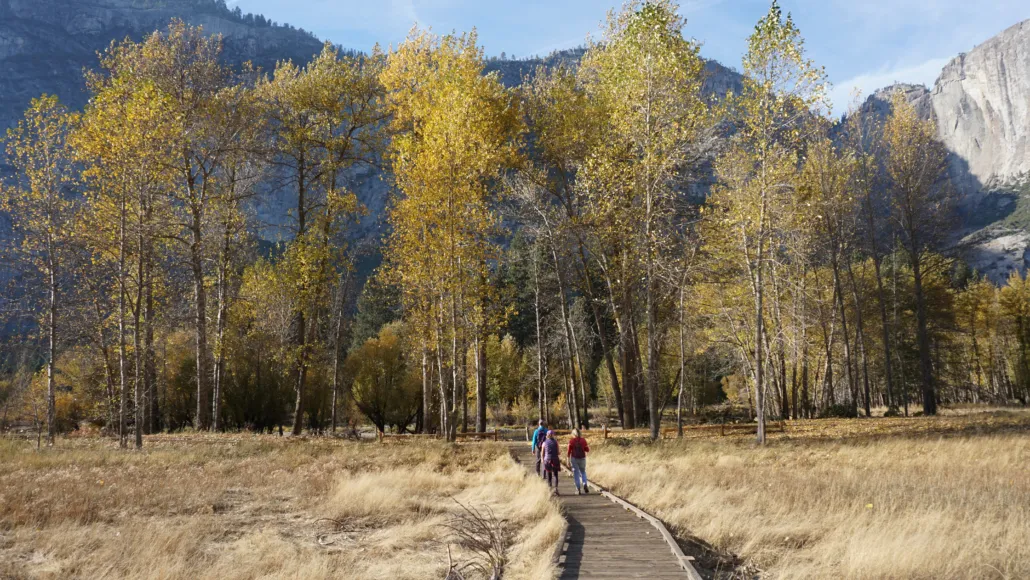
Mariposa Grove of Giant Sequoias Trail
- Difficulty: Moderate
- Distance: 2 miles (3.2 km) round trip to Grizzly Giant; 6.5 miles (10.5 km) for the full loop
- Elevation Gain: 500–1,200 ft (150–365 m) depending on the route
- Time: 1.5–4 hours
The Mariposa Grove Trail immerses hikers in a cathedral of ancient giants, massive sequoias that have stood for over a thousand years. This Yosemite National Park hiking trail winds through the largest sequoia grove in the park, offering access to famous trees like the Grizzly Giant and California Tunnel Tree. Whether you choose the shorter path to key landmarks or opt for the full loop, the trail delivers awe-inspiring sights and peaceful woodland atmosphere. Elevations rise gradually, allowing for a manageable yet enriching hike through one of the park’s most historically significant regions.
The grove is especially serene in the morning or late afternoon, when light filters softly through towering trunks. Wooden boardwalks protect delicate root systems, and interpretive panels enhance the experience with stories about the ecosystem and indigenous history. For those seeking a less crowded Yosemite National Park hiking experience with profound natural beauty, Mariposa Grove is unmatched. It’s a must-visit destination for tree lovers, families, and anyone curious about the timeless majesty of these forest giants.
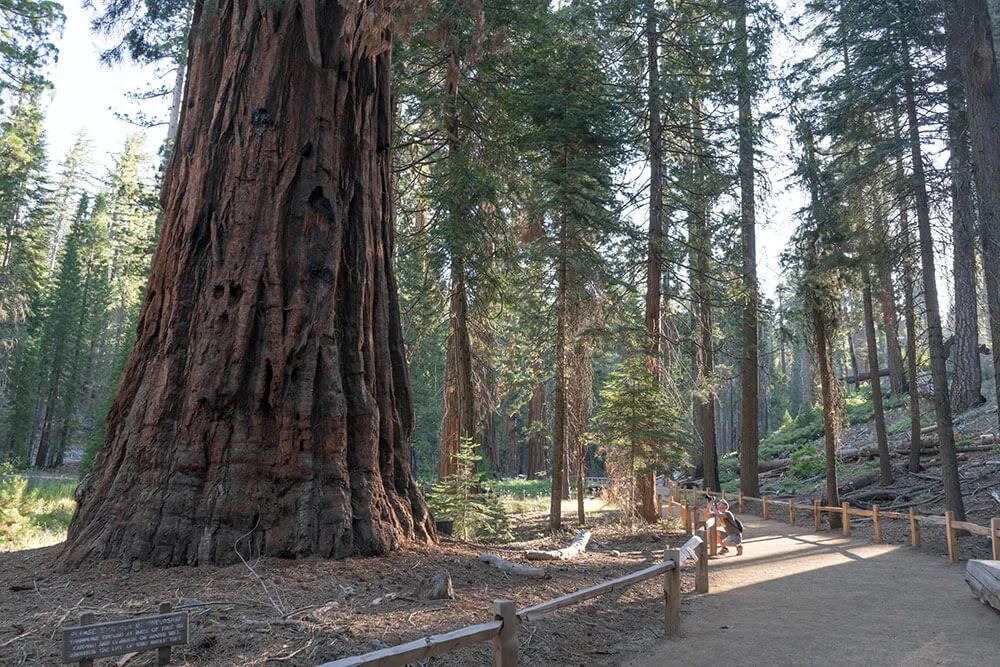
Snow Creek Trail
- Difficulty: Strenuous
- Distance: 9.4 miles (15.1 km) round trip
- Elevation Gain: 2,700 ft (820 m)
- Time: 6–7 hours
The Snow Creek Trail offers a demanding yet spectacular alternative to the more popular Yosemite ascents. Starting near Mirror Lake, this Yosemite National Park hiking route begins gently before transitioning into a relentless series of switchbacks that climb sharply to the north rim of Tenaya Canyon. The views become more dramatic with every turn, revealing sweeping panoramas of Half Dome, Clouds Rest, and the Merced River below. Unlike the crowded Mist Trail or Four Mile Trail, Snow Creek offers a quieter, more contemplative experience for serious hikers.
Once atop the rim, the trail levels off through a forested plateau that feels worlds away from the bustling valley. This area is less trafficked and ideal for solitude or even overnight backpacking with a wilderness permit. The climb is physically taxing and requires careful pacing and ample hydration, especially during warm months. For those looking to test their endurance while enjoying a pristine, high-altitude Yosemite National Park hiking trail, Snow Creek delivers both challenge and reward.
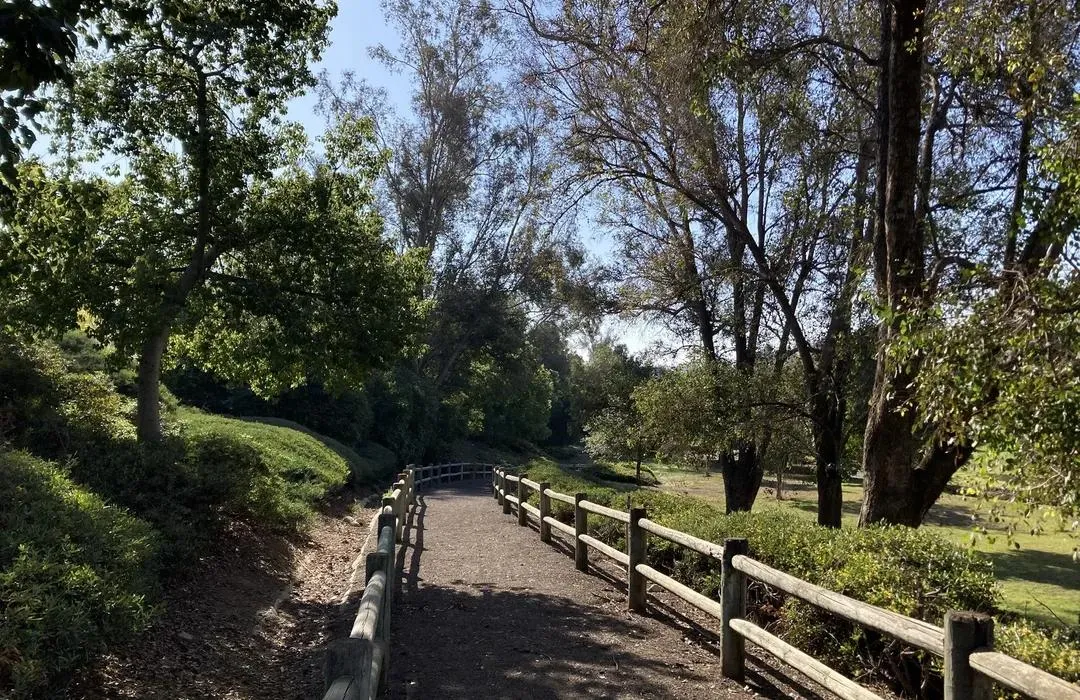
Indian Rock Trail
- Difficulty: Moderate
- Distance: Approximately 9.8 miles (15.8 km) round trip, including North Dome
- Elevation Gain: 2,090 ft (637 m)
- Time: 5–6 hours
The Indian Rock Trail is a hidden gem within the Yosemite National Park hiking system, leading to the only natural granite arch in the park. Starting at Porcupine Flat Trailhead along Tioga Road, the route passes through serene forests and meadows before reaching the unique rock formation. The arch frames an unforgettable view of Half Dome, offering a spectacular photo opportunity and a sense of discovery. This trail is moderate in difficulty, with steady climbs and occasional rocky terrain.
For hikers who crave variety, the trail can easily be extended to include North Dome, where expansive views of Yosemite Valley await. Because it lies outside the main valley, Indian Rock sees fewer visitors, making it ideal for those seeking solitude and lesser-known beauty. This hike delivers a blend of geological wonder, peaceful wilderness, and spectacular scenery. If you’re looking to branch out from the well-trodden paths, Indian Rock is one of Yosemite National Park’s most rewarding hidden routes.
>> Read More: Yosemite National Park Lodging: Check To Reserve

Cathedral Lakes Trail
- Difficulty: Moderate
- Distance: 8.2 miles (13.2 km) round trip to either Upper or Lower Cathedral Lake; 9.2 miles (14.8 km) round trip to visit both
- Elevation Gain: 1,000 ft (305 m)
- Time: 3–5 hours
The Cathedral Lakes Trail is a high-country favorite for those who want to experience alpine beauty without a multi-day trek. Beginning at Tuolumne Meadows along Tioga Road, this Yosemite National Park hiking trail rises gradually through meadows and pine forest before arriving at crystal-clear alpine lakes. Both Lower and Upper Cathedral Lakes are ringed by granite peaks, with Cathedral Peak standing tall and reflected in the still water. The scenery is pristine, the air thin and fresh, and the trail is moderately challenging but highly rewarding.
Wildflowers often bloom in the early summer, and the stillness of the setting provides a peaceful retreat from the more crowded parts of the park. This hike is particularly appealing to photographers and artists drawn to the symmetry and clarity of the lakes. Backpackers with permits often use this as a first-night stop along the John Muir Trail. Few Yosemite National Park hiking trails offer such striking high-altitude serenity in a single afternoon.
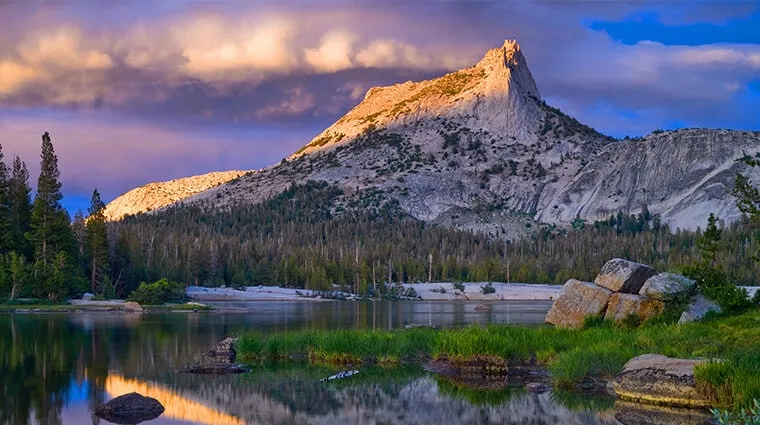
Four Mile Trail
- Difficulty: Strenuous
- Distance: 9.6 miles (15.5 km) round trip
- Elevation Gain: 3,200 ft (975 m)
- Time: 6–8 hours
Four Mile Trail is a spectacular route that connects the Yosemite Valley floor with Glacier Point – one of the most famous overlooks in the park. Despite its name, the full round-trip distance is nearly ten miles, with a relentless ascent that climbs more than 3,000 feet through exposed switchbacks. The effort is matched by views that just keep getting better, including El Capitan, Yosemite Falls, and Half Dome at nearly every turn. Spring and early summer are ideal seasons for this trail, when wildflowers bloom and waterfalls surge with snowmelt.
At the summit, Glacier Point offers an unforgettable reward: one of the finest panoramic vistas in the Sierra Nevada. There are restrooms, drinking water, and a visitor center available during the peak season. Some hikers opt to descend via the Panorama Trail for a loop experience, but even the out-and-back option is immensely satisfying. Among Yosemite National Park hiking options, Four Mile Trail is a demanding but iconic ascent that captures the drama of the entire valley.
>> Read More: Tunnel View Yosemite National Park: A Guide to Directions
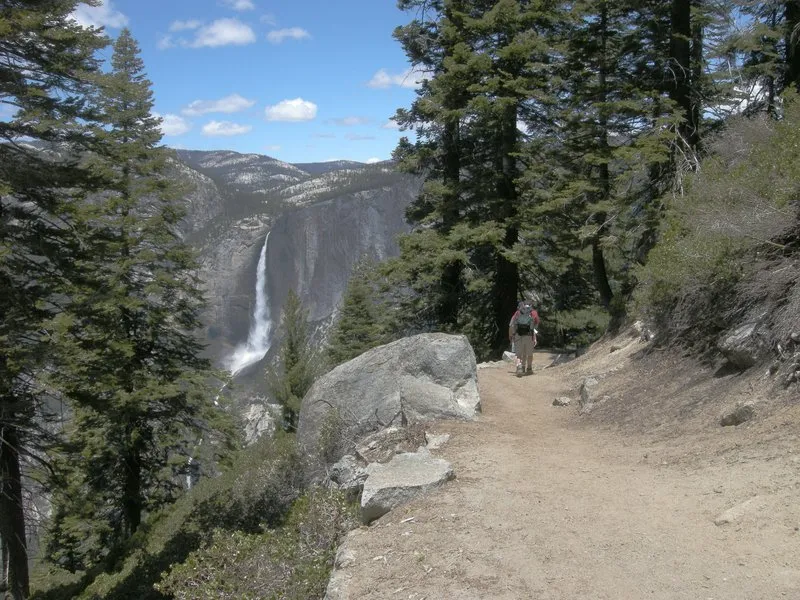
Map of Yosemite National Park Hiking
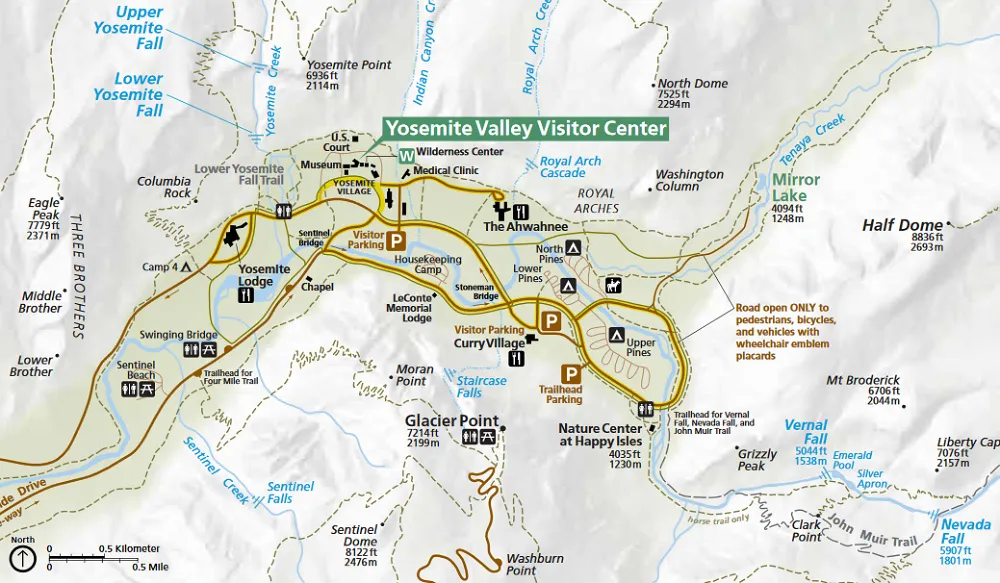
Tips for Hiking in Yosemite National Park
Hiking in Yosemite is not just about exploring epic landscapes, it’s about doing so safely, responsibly, and in harmony with nature. Whether you’re planning a short loop near Yosemite Valley or attempting a strenuous ascent like Half Dome, proper preparation can mean the difference between an unforgettable adventure and a trip cut short. These tips are grounded in decades of backcountry knowledge and are essential for anyone engaging in Yosemite National Park hiking. By following these best practices, you can enjoy the trails while preserving them for future generations.
Start Early
Morning light in Yosemite is magical. Beyond aesthetics, beginning your Yosemite National Park hiking adventure early allows you to take advantage of cooler temperatures, quieter trails, and better wildlife viewing. Many of the park’s most popular trails become crowded by mid-morning, so starting early not only offers solitude but also improves safety by reducing exposure to heat, especially on high-elevation hikes like Upper Yosemite Falls or Four Mile Trail. Early departures also give you a generous time buffer for unexpected delays or longer rest stops.
Stay Hydrated
The beauty of Yosemite’s wilderness can be deceiving, many of the park’s strenuous hikes involve significant elevation gain and dry, exposed terrain. Hydration is crucial, particularly in the summer months or at higher elevations. When preparing for Yosemite National Park hiking, pack at least two liters of water per person for half-day hikes, and more for full-day adventures like the Mist Trail to Nevada Fall or Cathedral Lakes Trail. Electrolyte-replenishing snacks or hydration tabs can also help you maintain energy and avoid cramps.
Check Trail Conditions
Before setting out, always consult the latest trail reports from the National Park Service. Rockfalls, snowmelt, and temporary closures can dramatically affect trail safety and accessibility. For example, Snow Creek Trail may be treacherous after a late-season storm, while access to Half Dome’s cables requires both permits and seasonal timing. Many Yosemite National Park hiking trails span diverse terrain, so what seems like a straightforward route can include flooded bridges, icy sections, or unexpected reroutes. A five-minute check online or at a ranger station can save you hours of trouble.
READ MORE:
Leave No Trace
Yosemite is a UNESCO World Heritage Site and sacred to many. Keeping it pristine is the responsibility of every visitor. Always follow Leave No Trace principles: pack out all trash, stay on designated trails to avoid trampling fragile ecosystems, and do not disturb wildlife or plants. Even small actions, like picking wildflowers or leaving food scraps, can have a long-term impact on the park’s delicate balance. Sustainable Yosemite National Park hiking starts with personal accountability and respect for this irreplaceable landscape.
Wildlife Awareness
It’s not uncommon to encounter deer, marmots, or even black bears while hiking in Yosemite. While these experiences can be thrilling, it’s important to observe wildlife from a distance for both your safety and theirs. Store food and scented items in bear-proof containers when backpacking, and never feed animals, it alters their natural behavior and can lead to dangerous encounters. During peak seasons, always check for wildlife advisories before embarking on your Yosemite National Park hiking route.
Conclusion
Yosemite National Park’s diverse hiking trails offer experiences ranging from serene walks to challenging climbs, each showcasing the park’s unparalleled natural beauty. Whether you’re seeking the misty allure of waterfalls, the tranquility of alpine lakes, or panoramic vistas from granite peaks, Yosemite’s trails cater to every adventurer’s dream. Proper preparation and respect for the natural environment ensure that these trails can be enjoyed safely and responsibly, preserving their splendor for generations to come.
>> Read More:

